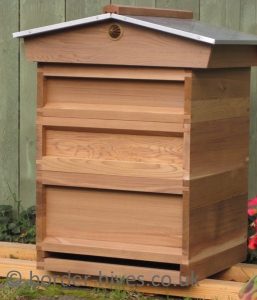As you will have seen elsewhere on the site I am using National sized hives and these are the most common hive type in the UK for amateur beekeepers. I have had some experience with WBC, commercial and Dadant equipment but didn’t see any advantages compared to using Nationals. With regards to WBC versus Nationals I would say only go for WBC if you are either given it for free or just want hives that look nice. I found WBCs to be a bit fiddly to manipulate and getting lifts, entrance blocks etc. to line up always seems to be a faff.
I’ve not had any experience with top bar hives and I guess it’s one of those love/hate relationships. Talking to people who use them they do seem to be more challenging to manage and the lack of wired foundation means the honey can’t be extracted from the combs easily and you are therefore restricted to cut comb.
Over the past 20 years the native British black bee has been cross bred with bees from more productive strains. As a result of this I think that average colony sizes have increased. This means that it is now typical to run a colony on either a “double brood” (2 brood bodies on top of one another) or “brood and a half” (a brood body and a super acting as a combined brood chamber). If I was starting out again I would go for what’s known as a 14 x 12 brood body which is roughly equivalent to a brood and a half in size. As a compromise I am running some of my hives with a standard National brood body plus an eke to make it the same size as a 14 x 12 brood body. The only caveat I would raise is that a 14 x 12 brood box full with bees and stores could weigh around 30-40 Kgs and so will be heavy if you need to move colonies around in your apiary.
Again decide on what hive type is best for your needs and stick to one type to make it easier to manage equipment between colonies.

